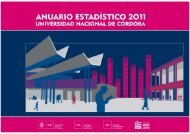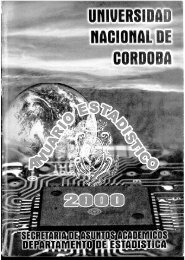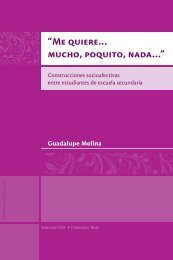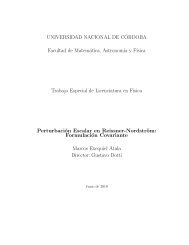Chapter I - RDU - Universidad Nacional de Córdoba
Chapter I - RDU - Universidad Nacional de Córdoba
Chapter I - RDU - Universidad Nacional de Córdoba
Create successful ePaper yourself
Turn your PDF publications into a flip-book with our unique Google optimized e-Paper software.
25victimized: women, native peoples, gays, etc. and they knowingly disrupt chronology,introduce supernatural occurrences and obviously historically inaccurate elements toremind the rea<strong>de</strong>r that history is a relative construct, riddled with subjectivity. Somemore wild-eyed postmo<strong>de</strong>rnists refuse to admit any real separation between fiction andhistory since both, in their view, are human-ma<strong>de</strong> “ways of world-making.” (cf.Van<strong>de</strong>rhaeghe Vol. 1 nos. 1-2)Regarding characters, Hutcheon compares the postulates that pertain to theclassical or traditional historical novel and confronts them with the situation inhistoriographic metafiction and she conclu<strong>de</strong>s that in this last case, characters are“anything but proper types: they are the ex-centric, the marginalized, the peripheralfigures of fictional history” for example Saleem Sinai in Midnight’s Children byRushdie. (Poetics of Postmo<strong>de</strong>rnism 114) Even real characters of history take on“different, particularized and ultimately ex-centric status” for example Richard Nixon inThe Public Burning by Coover. (Poetics of Postmo<strong>de</strong>rnism 114) In historiographicmetafiction Lukács’ ‘type’ has little function. This fiction sometimes falsifies knownhistorical <strong>de</strong>tails “in or<strong>de</strong>r to foreground the possible mnemonic failures of recor<strong>de</strong>dhistory and the constant potential for both <strong>de</strong>liberate and inadvertent error.” (Poetics ofPostmo<strong>de</strong>rnism 114) Here, historical characters are rarely relegated to secondary roles,and the subterfuge of trying to hi<strong>de</strong> the joins between history and fiction is not pursued,on the contrary, these novels pose that “ontological join as a problem: How do weknow the past? What do (what can) we know of it now?” (Poetics of Postmo<strong>de</strong>rnism115)There is a third possiblity put forward by Seymour Menton, a specialist in Latin-American historical novels. He uses the expression “new historical novel” to make adistinction between the traditional historical novels and the novels that narrate eventsfrom the past using postmo<strong>de</strong>rn techniques while also <strong>de</strong>fying the majority of theassumptions inherited from mo<strong>de</strong>rnism. (cf. Martini 98)The techniques and aspects that Menton i<strong>de</strong>ntifies as pertaining to this kind ofnovels are: a) the subordination of the mimetic reproduction of a given historical periodto the introduction of philosophical i<strong>de</strong>as such as the impossibility of really knowing thetruth of history and its cyclical and unpredictable characteristics, b) history is distortedthrough omissions and / or exaggerations, c) historical characters are fictionalised bywriters who enjoy creating sui generis versions of them, d) the use of intertextuality, e)the writer or narrator allows himself to make comments about or to reflect upon the
















